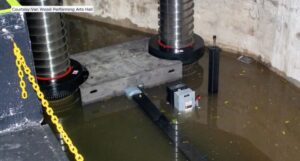In an interview with WSLR, David Bullock explains his plan for the historic building.
By Gretchen Cochran
Original Air Date: October 24, 2025
Host: The future of the Van Wezel Performing Arts Hall looks brighter now. WSLR News reporter Gretchen Cochran had an extended conversation with the City of Sarasota employee who is in charge of fixing the historic building and safeguarding it against future flooding. David Bullock is aiming to add more years to its life than the panel that recently came up with recommendations for the city.
[Star Wars (Main Title)]

Photo by Harriet Thorpe via keepthevanwezel.com
Gretchen Cochran: We think of the Van Wezel Performing Arts Hall as Sarasota’s place for traveling shows like the upcoming Broadway musical The Grinch and The Book of Mormon. But included in its creative programming is the movie The Empire Strikes Back. Sarasota’s Symphony Orchestra will perform the John Williams sound track as viewers take in the heroics of Han Solo, Princess Leia, Darth Vader and The Force.
The swirling, stormy plot is a bit akin to the theater’s last few years of conflicting forces, some wishing it be allowed to crumble while others wanting it spiffed up into perpetuity.
The recent placement of new flood panels at various doors and windows might be seen as symbols of an attitude to save a building that was seemingly undergoing what preservationists call “demolition by neglect.”
If it hadn’t been for two hurricanes last year, the Van Wezel might still be languishing, caught in a bureaucratic quagmire.
Two Karins Engineering reports in the last couple of years estimated nearly $17 million would be required to bring the 50-year-old building up to date. Most of the major systems, like heating and air conditioning and even the sound, needed tune ups at least.
The engineering studies sat, with no action to speak of. Meanwhile, an ad hoc panel called the Purple Ribbon study committee spent two years trying to draw up recommendations for the city commission. Should the Van Wezel be left to further deteriorate? Or should the city begin preparing the beloved-by-many entertainment venue for the next 50 years?

The Van Wezel has a basement 6 feet below sea level at its lowest point. During Milton, it flooded, and the transformer there was submerged in water. Photo: Van Wezel
Then came last year’s hurricanes, and suddenly, priorities changed. At first The Purple Ribbon Committee struggled with putting even a dollar into a building 15 feet from the water and parts of its basement below sea level. But ultimately, it submitted its report with a list of must-dos to shore up the building—at least for seven years when the committee projected a new Performing Arts Center might be ready for move-in.
The city commission accepted the report, but Commissioner Debbie Trice issued one proviso: Do not put this report on a shelf. She sought response back from the city staff describing how and when they would complete the needed work.
Within days, David Bullock, interim city manager, presented what he called A Comprehensive Resilience and Mitigation Action Plan for the Van Wezel, targeting completion in three years. His plan names about $7.2 million in federal and state grants, with matching money from a Van Wezel pool of money, totaling close to $10 million. And his plan would secure the building for 15 years, not seven.
The first item was the panels to attach to entries and windows to keep storm water out. Some are already installed.

David Bullock
David Bullock: They’re made out of aluminum or possibly stainless or some type of composite, depending on which ones we have. The ones I’ve seen are aluminum. They’re designed to protect the first several feet of any of the openings—windows, doors, anything like that. They bolt onto the frame, and they look like a metal plate. It’s really trying to keep the water out. They cover the window or the bottom half of the window or door, and they have a rubber gasket around them so that water can’t come in around them. We’re only going to put them on when we see a storm coming.
GC: Bullock and building people talk about “resiliency”—referring to how a building will fare through violent weather and how quickly it will recover afterward.
We asked him about the Aqua Fence, a system successfully used to protect Tampa General Hospital from flooding last year. Bullock explained how Sarasota will likely use a different approach.
DB: What we’re looking to do first is flood proof, obviously, so the water doesn’t get in like we’ve just talked about, and then try to absorb that wave energy way before it gets to the building, and that’s the offshore breakwaters. Those would be primarily rocks of pretty significant size. You’re not going to pick them up and play catch with them.

Photo by Harriet Thorpe via keepthevanwezel.com
GC: How long will it take to get the rocks? His explanation gives a hint about making things happen on a government project.
DB: Mostly it’s permitting time. You have to go through permits with the Army Corps of Engineers because they would be in navigable waters, and navigable waters in the U.S. are controlled by the Corps of Engineers. Since they would also sit on the bay bottom, they would also require a State Department of Environmental protection permit.
GC: He went on.
DB: Nothing gets done in this type of situation without an engineering design, generally a permit—and that often requires some type of a survey—then the contract and then construction. It’s not unusual, especially with something like a breakwater, to go through a year or more of permitting, and they build the thing in five months.

Promotional photo of the Van Wezel’s Roskamp Auditorium
GC: In Bullock’s overall plan, theatrical components like lighting and sound improvements aren’t addressed until 2027 and 2028. Why take so long?
DB: Our first priority is to make the building as flood resistant and resistant to storms as we can. That’s the first priority for all the facilities that we’re fixing. Second is all the theatrical improvements will need to occur off season—in other words, when the Van Wezel is not in normal production. Third, the theatre works. Right now, it works, and you can tell every weekend, every night, there’s hundreds or thousands of people there.
GC: Bullock has pledged quarterly public updates and what he calls “open communication on status, challenges and major milestones.”
For WSLR, this is Gretchen Cochran wishing, “May the Force be with you.”
[Star Wars (Main Title)]
WSLR News aims to keep the local community informed with our 1/2 hour local news show, quarterly newspaper and social media feeds. The local news broadcast airs on Wednesdays and Fridays at 6pm.